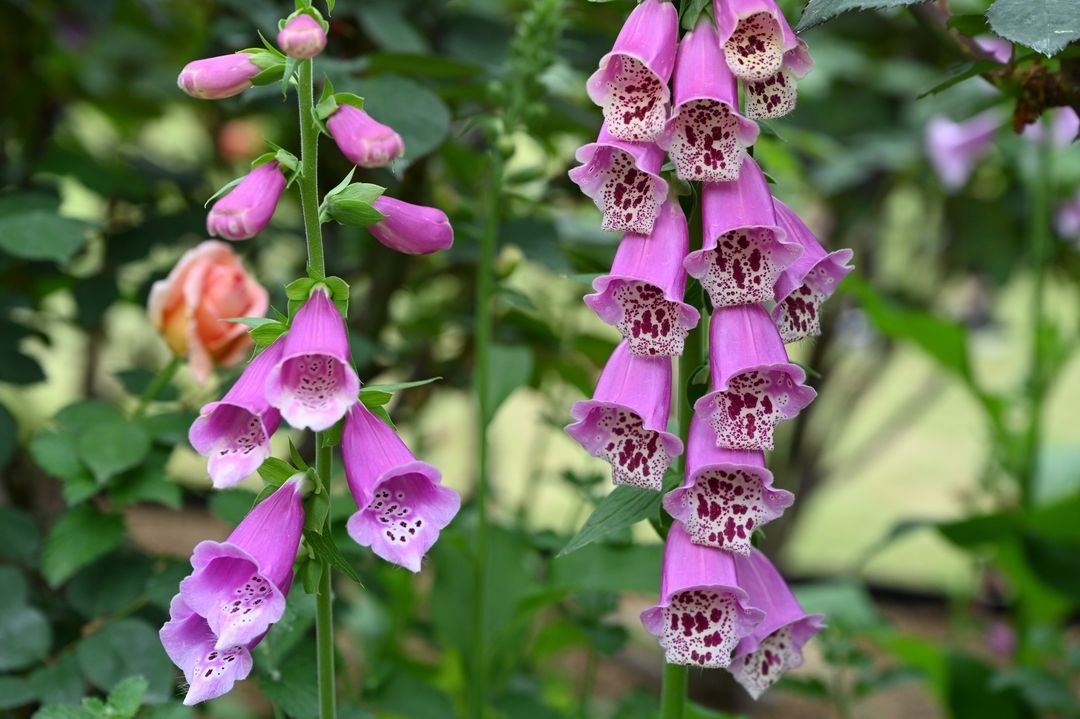Explore the complete guide to growing and caring for foxgloves. Learn how to cultivate these tall, striking flowers, including tips on planting, watering and ensuring a vibrant, long-lasting bloom in your garden.
Unlock the secrets to cultivating these iconic bell-shaped beauties with our comprehensive guide. From soil preparation to pruning techniques, we cover everything you need to know to successfully grow and maintain vibrant, healthy foxgloves (Digitalis) in your garden.
Here’s a detailed chart for foxglove:
| Category | Information |
|---|---|
| Botanical Name | Digitalis purpurea |
| Common Name | Foxglove |
| Plant Type | Biennial (sometimes perennial depending on the variety) |
| Hardiness Zone | 4-9 |
| Sun Exposure | Full sun to partial shade |
| Soil Type | Well-drained, moist, slightly acidic soil |
| Watering | Moderate; water regularly but do not let the soil become waterlogged |
| Growth Habit | Upright, with tall flower spikes |
| Height/Spread | 2-5 feet tall; 1-2 feet wide |
| Special Features | Showy, bell-shaped flowers on tall spikes; attracts bees and hummingbirds; highly toxic if ingested |
How to Grow, Look After and Care for Foxglove (Digitalis)

Foxgloves (Digitalis) are beloved garden favorites known for their tall spires adorned with delicate, bell-shaped flowers in shades of purple, pink, white, and yellow. These striking biennials (plants that complete their life cycle over two years) add a touch of whimsy and elegance to any outdoor space. While their beauty is undeniable, proper care and attention are essential to ensure their longevity and vibrant blooms. In this guide, we’ll provide you with all the information you need to successfully grow and maintain foxgloves in your garden.
Understanding Foxgloves
Before we dive into the growing and care instructions, let’s first understand the basics of these captivating plants.

Foxgloves are part of the Plantaginaceae family and are native to Europe, western Asia, and northwestern Africa. Their name, “Digitalis,” is derived from the Latin word “digitus,” meaning finger, referring to the shape of the flowers that resemble tiny thimbles or gloves fitting over a finger.
While foxgloves are generally grown as biennials, some cultivars may exhibit perennial qualities, allowing them to return year after year in milder climates. It’s essential to note that all parts of the foxglove plant are poisonous if ingested, so caution should be exercised when growing them around children and pets.
Choosing the Right Variety
Foxgloves come in a variety of cultivars, each with its unique charm and characteristics. Here are a few popular options to consider:
1. Common Foxglove (Digitalis purpurea)

This classic variety features tall spikes adorned with purple or white bell-shaped flowers and is a true garden stunner.
2. Foxy Hybrid (Digitalis x mertonensis)

A cross between the common foxglove and the strawberry foxglove, this hybrid boasts a range of colors, including pink, white, and apricot shades.
3. Strawberry Foxglove (Digitalis x mertonensis)

As the name suggests, this cultivar produces beautiful reddish-pink blooms reminiscent of strawberries.
4. Yellow Foxglove (Digitalis grandiflora)

A less common variety, the yellow foxglove showcases delicate, buttery-yellow flowers that add a touch of warmth to any garden.
Once you’ve selected your preferred variety, it’s time to start preparing for planting.
Planting Foxgloves
Site Selection
Foxgloves thrive in partial shade to full sun, making them versatile additions to various garden locations. They prefer well-draining, nutrient-rich soil with a slightly acidic to neutral pH range of 6.0 to 7.0. Avoid areas with heavy, wet soil, as foxgloves are susceptible to root rot in waterlogged conditions.
Starting from Seed
Foxgloves can be easily grown from seed, and this method is often preferred as it allows for a wider selection of cultivars. Sow the seeds indoors about 8-10 weeks before the last expected frost date in your area. Use a well-draining seed starting mix and plant the seeds 1/4 inch deep. Keep the soil moist but not waterlogged, and provide ample light.
Once the seedlings have developed their first set of true leaves, transplant them into individual containers or directly into your garden bed after the danger of frost has passed.
Planting Nursery-Grown Plants
If you prefer a more direct approach, you can also purchase nursery-grown foxglove plants. Plant them in early spring or fall, spacing them 12-18 inches apart. Dig a hole twice as wide as the root ball but no deeper than the height of the root ball itself. Gently loosen the roots and place the plant in the hole, backfilling with soil and watering thoroughly.
Caring for Foxgloves
Watering

Foxgloves require consistent moisture, especially during their first growing season, to establish a robust root system. Water them deeply, about once a week, or whenever the top inch of soil becomes dry. Avoid overhead watering, as this can promote fungal diseases.
Fertilizing
Foxgloves benefit from a balanced, slow-release fertilizer applied in early spring. This will provide the necessary nutrients for healthy growth and abundant blooms. Avoid over-fertilizing, as too much nitrogen can lead to lush foliage growth at the expense of flowers.
Deadheading
To encourage continuous blooming and prolong the flowering season, it’s essential to deadhead spent foxglove flowers regularly. Simply snip off the faded blooms at the base of the stem, taking care not to damage the healthy foliage or buds. This prevents the plant from going to seed and redirects its energy into producing more vibrant flowers.
Staking
As foxgloves grow taller, their tall spikes may require staking or support to prevent them from toppling over, especially in windy conditions. Use sturdy garden stakes or a tomato cage to gently support the plants, being careful not to damage the stems or roots.
Overwintering
In most climates, foxgloves are treated as biennials, meaning they will complete their life cycle over two years. After flowering in their second year, the plants will naturally die off. To ensure a continuous supply of foxgloves, it’s recommended to sow new seeds annually or divide any established clumps in the fall.
If you live in a mild winter region (USDA Hardiness Zones 7-10), some foxglove cultivars may exhibit perennial qualities. In these cases, cut back the spent foliage in late fall and apply a thick layer of mulch around the base of the plants to insulate the roots and protect them from freezing temperatures.
Troubleshooting Common Issues
While generally hardy plants, foxgloves can be susceptible to a few common issues.
Here’s how to identify and address them:
Pests
Foxgloves are relatively pest-resistant, but you may encounter occasional problems with aphids or slugs. Aphids can be controlled using insecticidal soap or neem oil, while slugs can be deterred with diatomaceous earth or copper barriers.
Diseases
Fungal diseases like powdery mildew, leaf spot, and rust can affect foxgloves, especially in humid or poorly ventilated conditions. Maintain good air circulation around the plants, avoid overhead watering, and promptly remove any affected foliage to prevent the spread of disease.
Wilting or Discoloration
If you notice your foxgloves wilting or developing discolored foliage, it may be a sign of improper watering or nutrient deficiencies. Adjust your watering schedule and consider supplementing with a balanced fertilizer to address any potential issues.
Enjoying the Beauty of Foxgloves
One of the greatest joys of growing foxgloves is witnessing their breathtaking blooms in your garden.
Here are a few tips to make the most of their stunning display:
- Incorporate foxgloves into mixed borders or cottage-style gardens for a romantic, whimsical touch.
- Plant them in drifts or clusters for a bold, eye-catching statement.
- Use them as cut flowers in bouquets or arrangements for a touch of elegance indoors.
- Pair them with complementary plants like delphiniums, peonies, or ornamental grasses for a harmonious and visually striking combination.
With their captivating charm and relatively low-maintenance nature, foxgloves are a must-have for any garden enthusiast. By following the guidance in this comprehensive guide, you’ll be well-equipped to cultivate these iconic bell-shaped beauties and enjoy their magnificent blooms for years to come.
Pingback: How to Grow Hollyhocks: A Step-by-Step Guide -
Pingback: Foxglove Beardtongue: Growing Tips for Vibrant Blooms
Pingback: Peat-Free Gardening : Debunking the Myths and Embracing Sustainable Solutions
Pingback: Power of Chicken Manure Pellets : A Gardener’s Guide to Nutrient-Rich Goodness
Pingback: Explore 20 Fascinating Flowers Beginning with F - Gardener's School
Pingback: Foxglove Flowers : Nature’s Delicate Charm - USA Garden Web